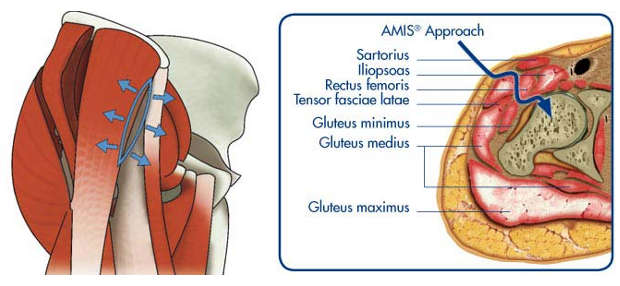
Recently there has been an increase in interest in performing hip replacement surgery by less invasive means, and by smaller incisions. Some of these so called minimally invasive techniques however (posterior, lateral, or double incision) are only reduced skin incision techniques and are associated with the same muscle and/or tendon injury as “conventional” approaches.
AMIS® (Anterior Minimally Invasive Surgery) however, is a surgical technique used in total hip replacement procedures which follows an inter-muscular and inter-nervous plane to reduce the risk of injury to muscles, tendons, vessels and nerves. By respecting the nerves and because no muscles are cut this aids in rapid recovery for patients following surgery.
The History of AMIS®
The anterior approach to the hip joint was first described by a German surgeon Dr Hueter in 1881. It was initially used for draining infected joints.
French surgeons used the anterior approach with the first total hip replacements in 1949 and continue up to the present day.
Prof. Frederick Laude in Paris adapted the approach 12 years ago and modified the traction table and tissue retractors used in the operating room to create a truly “minimally invasive approach” to the hip for joint replacement. His approach was termed AMIS® (Anterior Minimally Invasive Surgery).
The AMIS® Approach
When having a hip replacement a very important consideration is the method used by your surgeon to insert the artificial joint. A Direct Anterior Approach (AMIS®) is a method of inserting the artificial joint through the front (ie. anterior) without cutting any muscles or damaging nerves. All other common approaches (ie. lateral and posterior) involve cutting muscles or tendons.
The procedure is performed in hospital as an inpatient. This means that the hospital stay is usually overnight but may be longer, depending on your individual circumstances. The operation will take approximately 1.5 hours.
The incision is approximately 7 -10 cm long. The incision is made over the top of your hip joint in the region of your groin. The worn surfaces of the hip are removed and the surfaces are replaced with artificial components. Metal is used for all components however the bearing surfaces may vary depending on the circumstances: metal, ceramic, or plastic.
Ligaments and tendons are preserved so it is possible following a primary joint replacement to walk a few hours after surgery, fully weight-bearing on your new hip. In fact, it is something that we want you to do unless otherwise advised. At the site of the operation the tissues may not be completely flat immediately after surgery because of some swelling. This will however settle down a few weeks after surgery.
The anaesthetic service is provided by Dr Dennis Kerr. He will discuss your anaesthetic and pain control at a consultation before your surgery. It is essential that you see Dr. Kerr in preparation for the operation and that your spouse, partner, or significant other person in your life come to the consultation as well. The importance of this consultation cannot be overemphasised.
Click on the Video below for a step by step guide on the AMIS® surgical technique:
Conventional Approaches vs AMIS®
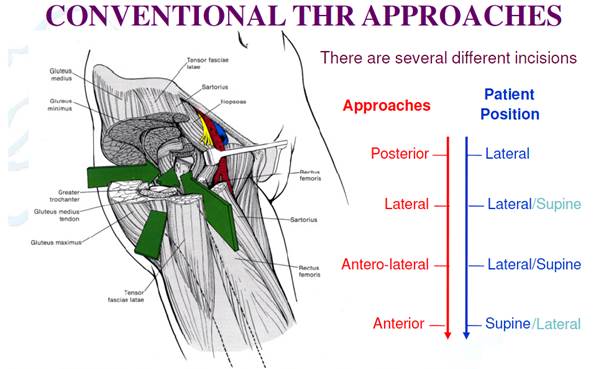
Conventional – Antero-lateral
In the conventional-antero-lateral approach the hip abductor (gluteus medius and minimis) muscles/tendons are detached and split, frequently resulting in a permanent limp as they are unable to stabilise the hip after the operation. Bone lumps often grow in the damaged gluteus muscle. This apprach also cuts through the tendons of gluteus maximus and tensor fascia lata muscles.
Conventional – Posterior
In the conventional-posterior approach the gluteus minimis muscle is cut off the capsule often resulting in lumps of bone growing in the muscle after the operation. This approach has the highest risk of dislocation but there is usually no limp after surgery. The posterior approach also cuts through the tendons of gluteus maximus, tensor fascia lata, piriformis, gemelli and obturator muscles.
AMIS® Approach
The AMIS® incision is only 7-10cm in length, whereas antero-lateral or posterior approach incisions are usually between 15-30cm in length!
With AMIS® there is no detachment, splitting or denervation of muscle. No muscles or tendons are cut as they are simply retracted to create a gap. The tensor fascia lata muscle is retracted laterally whilst the rectus femoris muscle is retracted medially. There is no gluteal (buttock) muscle injury with this approach.
The gluteal muscles provide the main hip power and stability and as they are entirely intact with the AMIS® approach a faster recovery is expected. The posterior or antero-lateral approaches cut through the buttock muscles and tendons even when they are so-called mini-incisions or mini-invasive operations.
The AMIS® approach enters between the nerve supply to the muscles so the muscle fibres retain their full ability to function after the operation. Other approaches permanently damage either muscle fibres and/or the nerves which supply them so there may be a permanent loss of nerve function and/or partial muscle wasting.
Remember that ALL approaches if performed correctly will result in a successful pain free outcome that should last at least 20-30 years using modern day implants.
Advantages of AMIS®
AMIS® can potentially provide you with the following benefits:
DECREASED POST-OPERATIVE PAIN
In comparison with “conventional” surgical techniques, the AMIS approach can reduce the post-operative pain as muscles are not cut.
SHORTER REHABILITATION
Rehabilitation can usually start the day of the operation or the day after, subject to your doctor’s approval, based on your post-operative conditions. Standing up and walking with arm crutches can start immediately, with your doctor’s authorisation as well.
SHORTER HOSPITAL STAY
The AMIS® technique usually significantly reduces the duration of hospital stay. Your surgeon may still recommend you a longer stay depending on your post-operative condition.
SMALL SKIN SCAR
With AMIS®, the skin incision is often shorter than with “conventional” surgery and therefore scar tissue is reduced.
FASTER RETURN TO DAILY ACTIVITIES
The AMIS® technique allows you to return to daily activities in a shorter time frame.
LESS BLOOD LOSS
Preservation of muscles and vessels potentially reduces blood loss. Transfusions are rare, blood clots in the legs (deep venous thrombosis) are potentially less likely.
REDUCED RISK OF DISLOCATION
(separation of the hip ball and socket)
As a result of the AMIS® technique the preservation of muscles significantly improves the stability of the hip. The risk of dislocation is minimal and the post-operative limitation of movements, usually prescribed in other techniques, is not necessary. The risk of dislocation is reduced because the anterior approach is performed from the front of your body and dislocation is mainly related to posterior hip structure damage.
PREVENTION OF LIMPING
AMIS® is characterised by a surgical technique that protects the various muscles, blood vessels and nerves encountered during exposure of the hip joint. Minimizing muscle and nerve damage reduces the chances of limping.
You may drive when able to get in and out of the car comfortably, have excellent control of your legs and are not taking pain medications.
Depending on your general condition and only with approval from your surgeon, you may be driving in 8 -10 days.
Types of Prosthesis for AMIS®
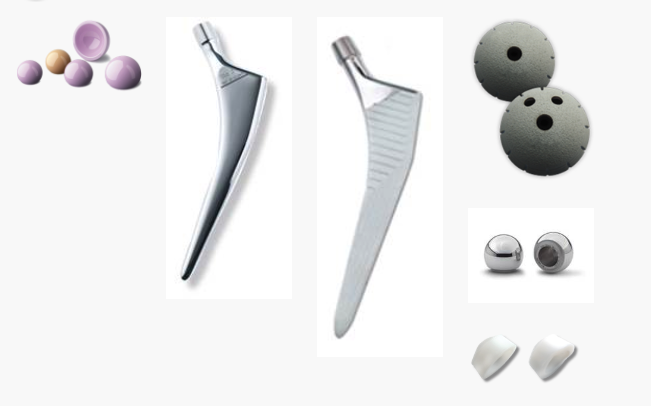
The prosthetic implant used in hip replacement procedures consist of different parts; the acetabular component, the femoral component and the articular interface. Options exist for different patients and indications. Correct selection of the prosthesis is important.
- Acetabular Component: The Acetabular cup is the component which is placed into the acetabulum (hip socket). Cartilage and bone are removed from the acetabulum and the acetabular cup is attached using friction or cement. Like a healthy hip, your prosthesis has smooth gliding surfaces that allow you to move easily and without pain. Materials may vary, including steel, plastic (Polyethylene) or ceramic. Some acetabular cups are one piece, while others are modular. One piece (monobloc) shells are either polyethylene or metal, they have their articular surface machined on the inside surface of the cup and do not rely on a locking mechanism to hold a liner in place. A monobloc polyethylene cup is cemented in place while a metal cup is held in place by a metal coating on the outside of the cup. Modular cups consist of two pieces, a shell and liner. The shell is made of metal, the outside has a porous coating while the inside contains a locking mechanism designed to accept a liner.
- Femoral Component: The femoral component is the component that fits in the femur (thigh bone). Bone is removed and the femur is shaped to accept the femoral stem with attached prosthetic femoral head (ball). There are two types of fixation: cemented and uncemented. Cemented stems use acrylicbone cement to form a mantle between the stem and to the bone. Uncemented stems use friction, shape and surface coatings to stimulate bone to remodel and bond to the implant. Stems are made of multiple materials (titanium, cobalt chromium, stainless steel, and polymer composites) and they can be monolithic or modular. Modular components consist of different head dimensions and/or modular neck orientations; these attach via a taper similar to a Morse taper. These options allow for variability in leg length, offset and version. Femoral heads are made of metal or ceramic material. Metal heads, made of cobalt chromium for hardness, are machined to size and then polished to reduce wear of the socket liner. Ceramic heads are more smooth than polished metal heads, have a lower coefficient of friction than a cobalt chrome head.
- Articular Interfaces: There are four alternative articular interfaces that could be used:
- Metal on Polyethylene: This is the traditional material which has been used for many years. There has been significant improvements in the polyethylene over the last 5 years. Ultra crossed linking of the molecules has dramatically reduced the wear of the polyethylene and this has allowed for larger ball heads to be used. With larger balled heads the risk of hip dislocation has been shown to be significantly reduced.
- Ceramic on Polyethylene: There has been significant improvements in the polyethylene over the last 5 years. Ultra crossed linking of the molecules has dramatically reduced the wear of the polyethylene. Ceramic has a very low wear rate, it is however somewhat brittle in structure and there is a small but definite incidence of fracture of the ceramic.
- Ceramic on Ceramic: This has a very low wear rate. It is also a very bioinert substance, in that the wear debris does not seem to cause significant problem either locally or elsewhere in the body. It is however somewhat brittle in structure, and there is a small but definite incidence of fracture of the ceramic. If this occurs it requires urgent revision of the articulating surfaces.
- The other baring surface is Metal on Metal which Professor Kohan does not use. This is because recent studies have shown that metal-on-metal devices may have problems. This is by no means universal, and there are some well functioning, well-established, durable implants which have been used and continue to be used. Metal on metal devices have been used for over 40 years in patients with high activity levels. However, some recent implants, have proved unsatisfactory, and have been withdrawn from the market. Hip resurfacing surgery at this stage can only be carried out with metal on metal implants. The metal on metal implants which are currently used have a long track record of durable, consistent, and reliable function. However, being mindful of the recent problems being attributed to metallic implants, in this practice we only use these bearings under specific circumstances, which will be discussed in detail with the patient at the time.
Precautions following AMIS® THR surgery
There are precautions necessary to undertake after hip surgery. The major precaution is limiting hip extension. This is different from most hip replacement procedures which are done from the back and limit flexion.
With the anterior approach, hip flexion is unlimited but hip extension needs to be restricted for a period of six weeks after your operation.
Do not do this hip extension exercise for 6 weeks following surgery.
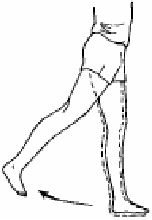
INCISION CARE
The incision is usually closed with skin staples. These need to be removed 10 days after surgery. Sometimes, dissolvable stitches are used, which do not require removal. A decision is made on the basis of local circumstances at the time of the operation.
You may not get the incision wet until the staples are removed; a sponge bathe 10 days after surgery instead of a shower is recommended.
You may shower 2 days after the sutures are removed, but may not bathe or swim until 2 weeks from surgery.
You may apply Vitamin E or some moisturizing lotion to the incision after the staples, or dressings are removed.
Some swelling and warmth is expected after surgery however if you develop increased redness, oozing from the cut, or fever, please call the office immediately.
WALKING
You will be out of bed and walking within 4 hours after surgery. Upon discharge from hospital you will be walking with crutches. You may discontinue using crutches after being assessed by Professor Kohan, 1 to 2 weeks after surgery. After this time you may use a cane or if you feel confident you may discontinue using walking aids.
You may go up and down stairs as needed but only straight legged for the first 2 weeks. Use the following sequence: lead with GOOD LEG, then bring forward the crutches, then bring forward the operated leg through the crutches and repeat the sequence.
After this time there should be enough flexibility and comfort to gradually decrease the dependence on walking aids but there is no rush, it depends entirely on your confidence and security to walk without them.
EXPECTATIONS
Each individual has his/her own set of expectations. Each individual is different. Each patient is treated as an individual with general health, age and attitude considered.
One of the important things to remember is that you are not ‘sick’ but have a problem with your hip that needs to be fixed. Getting back on your feet after surgery is the most important goal: “Motion is Lotion”.
In the first week following surgery you may experience:
-
-
- Swelling – From your thigh down into your foot is common. This at times may be quite marked. The swelling will increase for the first few days after surgery and will gradually diminish. Some swelling can be present for 12 months or so. The swelling may be diminished by walking as the muscle function will push the fluid away. When you stop walking, the limb should be elevated above the level of the hip.
- Bruising – Marked bruising can be found in some patients. This can be found from your thigh down into your foot. At times the bruising can be quite dramatic but it will resolve. It is the result of some residual bleeding making its way to the surface. The body will eventually remove the bruising. It is also the result of the blood thinning tablets you will be taking.The blood thinning tablets will tend to make the bleeding after surgery a little more marked because the blood clotting is impaired. This is however preferable to developing a blood clot.
- Blistering – On occasions blisters will develop near the operation and possibly above it. The blistering is due to surface fluid. It looks dramatic but it is of no consequence and always resolves. One cause may be the bandage rubbing on the skin. Sometimes, when the blood dries in the bandage it can be like cardboard and rub on the skin producing these blisters. We change the bandage after about a week but would prefer not to interfere with that earlier because of the risk of infection. After about a week the wound is sealed enough to be a reasonable barrier against infection. Another cause for the blistering is tissue swelling. This is associated with the bruising and is a result of fluid leaking into the skin. These blisters always go away. They may burst and leak fluid and again the appearance may be dramatic. Sometimes if they are large we may burst them. This is so that the dressings sit more comfortably.
- Muscle soreness – Your muscles can feel stiff and sore to touch. During the operation some stretching and pulling of the muscles occurs. This may result in some pain like a corked thigh. Occasionally you may feel cramps and spasms. The discomfort however will resolve and activity such as walking, stretching, physiotherapy, etc, will help to speed the improvement.
- Heat – The operated site may feel hot and the heat may last for 12 months. As part of the healing process the operation site requires more blood supply from the body and it is this extra blood supply which is the cause of the local heat.
-
Modified activity level
For the first 2 weeks after surgery your activity level is usually limited however, you will be able to walk independently, use the bathroom and perform normal activities of daily living. Remember, this operation is done from the front. As a result hip bending will not be limited.
NOTE: Be wary of advice from other sources in relation to activities which you will undertake. Other well-meaning people may advise you in relation to a toilet seat raise, bending of the hip, pillow in bed, etc. While this advice may be relevant to other types of operations it is not in the case of this operation. If in doubt, ask!
After 2 weeks you will be able to engage in moderate activities such as driving a car and climbing stairs.
Within 6 weeks you will have resumed most of your normal activities. Complete surgical healing takes 6 – 8 weeks. During this time some swelling and discomfort is normal and should be manageable with the prescribed medication.
The most important thing is to have a positive attitude. Replacing your hip can relieve your pain and stiffness and return you to most of your activities you enjoy.
With the anterior approach you can look forward to getting back into the swing of things and enjoying life as it was before you were in pain.
AMIS® FAQ
How long will my leg continue to swell and hurt?
The pain usually decreases rapidly during the first few weeks but the pain continues to improve for 12 months or even longer. The swelling is due to alterations in fluid return up the limb and will gradually diminish but may take 12 months or longer. Mobilisation helps. Exercise, stockings and elevation also help.
How much exercise should I do and how can I tell if I have done too much?
Mild and moderate exercise is beneficial but over-exercise is painful and possibly harmful. Generally the more active you are the better, but within limits.
When can I drive?
Driving is an individual matter. Some people regain their co-ordination and reflexes quickly and others take longer. Following hip surgery you should avoid driving for at least 2 to 3 weeks depending on your progress. Driving should not be considered if you are still taking pain medication.
When will I be able to go up and down stairs?
On the first day after surgery you should learn to walk up and down stairs with a physiotherapist at the hospital. The pace at which you regain agility on stairs depends on individual traits.
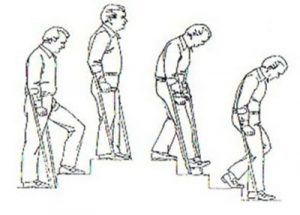
Up stairs: Take a step up with your good leg, then take the operated leg, followed by crutch or stick.
Down stairs: Place your crutch or stick first, then take a step down with the operated leg, followed by the good leg. Always go one step at a time.
What kind of shoes should I wear?
High heels should be avoided for the first 3 months otherwise there are no rules regarding shoes.
Should I use a heating pad or ice packs?
Both ice and heat can be used to help relieve pain but both can be harmful if left on too long. Never sleep with a heating pad on your hip as it can damage the skin and even cause a severe burn. Ice can be used several times a day. 20 minutes on and 20 minutes off is the usual regime.
How long should I continue taking my medications after surgery?
If iron is prescribed, it should be continued for 1 month after discharge from the hospital. Blood thinning medications (Aspirin) should be taken for 6 weeks. All pain medications may be taken as directed for pain. If you have any questions about your medications please ask.
Why do I have trouble sleeping at night?
Sleeping trouble is the most common question. You need patience. Surgical heeling takes approximately 6-8 weeks. Therefore you may be slightly uncomfortable for this time. Taking prescribed medication and applying ice can help. Also getting out of bed and moving the joint sometimes helps too.
Why don’t my legs feel equal in length?
This is a very commonly asked question. There are many reasons why you may feel a limb length discrepancy. During surgery, we used several methods to ensure limb length inequality, as best we can. Given current technology, probably, plus or -1 cm is about as accurate as we can get. Generally speaking, though, you need at least 1/2 cm or more before a permanent limp develops. This is because the spine of the pelvis can usually accommodate for the limb length inequality.
Another reason is that, before surgery, the hip is quite stiff. Over the years, you have gradually adapted to the stiff hip, by altering the angle of your pelvis and the spine. That is the new “” normal”” length with which you going to surgery. After the surgery, much of the stiffness is immediately resolved, and the limb can now extend fully giving you the feeling that it is longer. It feels longer, but in fact the length is the same as it was before surgery, it is just able to be extended fully.
We usually advise that you adopt a wait and see approach. Simply using the leg, walking, and gentle exercises as advised will allow the body skeletal system to adapt. This may take a year. However, if you use shoe raises, or insoles to make up for the perceived inequality, the body does not have a chance to adapt.
Phone
Locations
Bondi Junction
Suite 301C, 9 – 13 Bronte Road
Bondi Junction, NSW, 2022
